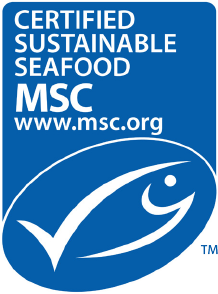Tiikati, Chilean hake, Patagonian hake, Southern hake
The New Zealand hake trawl fishery is a well managed and sustainable fishery in accordance with the Marine Stewardship Council's Principles and Criteria for Sustainable Fishing.
New Zealand hake is harvested mainly by trawl from the South Island, off the east and west coasts and in sub-Antarctic waters. Hake are widely distributed throughout the middle depths of New Zealand waters. Adults are mainly found between 250 and 800 m, while juveniles are found in inshore regions shallower than 250 m. Hake start breeding around 6 – 10 years and live to roughly 25 years.
M. australis look similar to other hake but are distinct and only found in New Zealand and Patagonia.
The two main hake fisheries in New Zealand, off the west coast of the South Island (HAK 7) and on the Chatham Rise (HAK 4), have traditionally consisted of bycatch in the much larger hoki fisheries. In recent years, both have become important target fisheries. The hake fisheries overlap with the hoki and ling fisheries. As such, they are often considered and managed as a complex. Hoki and ling are both MSC-certified fisheries.
Hake is managed by Fisheries New Zealand (FNZ) using the Quota Management System (QMS). FNZ works in partnership with Seafood New Zealand | Deepwater Council (a not-for-profit organisation that works on behalf of fisheries quota owners). The two parties developed a joint-management framework with agreed strategic and operational priorities and work plans. The partnership is focused on determining the maximum economic yield of the deepwater fisheries by setting catch limits that maximise returns over the long term within the constraints of ecological sustainability.
The MSC Certification covers 55% of all hake caught in New Zealand. Hake was re-certified in September 2018, however, HAK 7 was withdrawn from certification in 2019.
For more information, download the full MSC Certification Report.
The MSC scheme follows international benchmarks to promote robust processes and uphold values of independence, transparency, impartiality and stakeholder consultation.
The MSC assessment process is run by an independent certification body (accredited by Accreditation Services International GmbH). A group of auditors (with expertise in the fishery and ecosystems under consideration) are responsible for scoring the performance of the fishery based on scientific evidence. Auditors must meet the qualifications and competencies set out in the MSC Certification Requirements.
In order to achieve MSC certification, a fishery must pass 28 performance indicators within three core principles: sustainable stocks, minimising environmental impact and effective management.
The certification process takes between 6 and 18 months. The assessment process includes opportunities for stakeholder input and peer review. Certification lasts up to 5 years, during which time the fishery makes any improvements required as a condition of certification. Annual audits are carried out by the certifier to ensure continued compliance. A full reassessment of the fishery must be completed within five years of the last certificate being granted.
The information presented on this page is extracted from the MSC Public Certification Report and most recent Surveillance Audit Report. More information can be found at www.msc.org


Assessment Summary

Sustainable target fish stocks
Principle 1 states a fishery must be conducted in a manner that does not lead to over-fishing or depletion of the exploited populations and, for those populations that are depleted, the fishery must be conducted in a manner that demonstrably leads to their recovery.
The current management approach for all hake stocks is based on stock assessment models and involves regular reviews of the total allowable catch (TAC) and total allowable commercial catch (TACCs). Changes to the TAC/TACCs or any other management measures are implemented to ensure the stocks are managed to the default target and limit reference points as specified in the Harvest Strategy Standard. The stock assessment results are reported in the Fisheries New Zealand Fisheries Assessment Plenary documents, with the likelihood of current and projected stock status being below target and both soft and hard limit levels being reported. Scientific advice is consistent with achieving the target biomass and achieving acceptable risks.
The current biomass for each hake stock is well above the target reference point and is at a level that maintains high productivity and has a low probability of recruitment overfishing. The estimated catch has been less than the TACC since 2005 in all regions and does not currently constrain catches.
Environmental impact of fishing
Principle 2 states that fishing operations should allow for the maintenance of the structure, productivity, function, and diversity of the ecosystem (including habitat and associated dependent and ecologically related species) on which the fishery depends.
A management strategy is in place for the hake fishery that is highly likely to achieve national and international requirements for the protection of endangered, threatened, and protected (ETP) species. For the hake fishery, interactions focus on seabirds and marine mammals.
The hake trawl fishery is not thought by experts to represent an especially high risk for seabird populations, as long as effective management measures, including mitigation, are in place. Seabird captures in the hake fishery account for approximately 3% of seabirds caught in New Zealand offshore trawl fisheries (based on data from 2007/08 and 2008/09). Captures of potentially at-risk species require particularly careful monitoring to ensure that the impact of the hake fishery does not threaten sustainability. By law, trawlers over 28 m in length fishing in New Zealand waters are required to use one of three specified devices to reduce seabird interactions with trawl warps; paired streamer lines, a bird baffler or a warp scarer.
Interactions between the hake trawl fishery and marine mammals are typically with fur seals. Fur seal populations are monitored, and estimates of total New Zealand population sizes, and number of breeding colonies are generally increasing. Overall, the hake trawl fisheries are highly unlikely to directly affect the growing population, although continued study is warranted.
No interactions have been noted with sea lions within the hake fisheries.
Effective management
Principle 3 requires that a fishery is subject to an effective management system that respects local, national, and international laws and standards and incorporates institutional and operational frameworks that require use of the resource to be responsible and sustainable.
The hake management system has an effective monitoring, control and surveillance system, including satellite vessel monitoring systems, government observers, and accurate reporting and record-keeping. Sanctions to deal with non-compliance in the fishery exist, and are consistently applied. However, the preferred approach is to work collaboratively with industry to prevent non-compliance.
The National Fisheries Plan for Deepwater outlines the objectives for all deepwater and middle-depth fisheries. The chapter specific to the hake fishery has specific objectives tailored to the hake fisheries that are achievable, and which directly guide actions in the hake fisheries. These are then specified within the Annual Operational Plan each year. These fishery specific objectives are subject to the Annual Review report and are measurable.
The hake fishery has been managed within the Quota Management System since its inception in 1986.
Summary of assessment conditions
There are no conditions.

